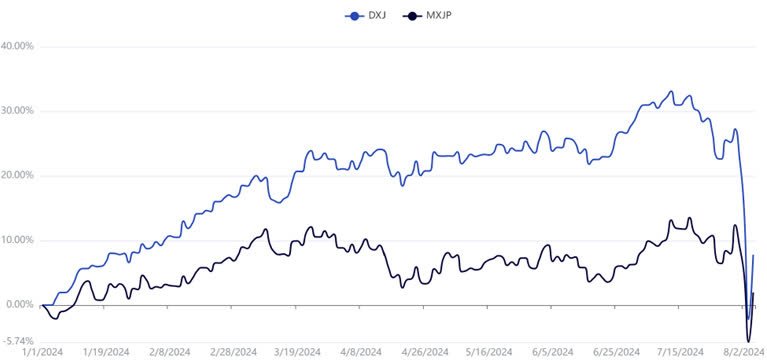
gyro
By Bradley Krom
The Bank of Japan (BOJ) created quite a stir in markets following its Monetary Policy Meeting on July 30-31. We’ve had several client calls attempting to untangle exactly what has caused the USD/JPY to move from 162 to 141 (and, as of this writing, to 147) in only a couple of weeks and the Nikkei to fall by close to 20% in only a few days.
I believe investors should be adding to their currency-hedged Japan exposure as opposed to selling. Let’s dig into some details.
First on the Policy Changes
Rate Hike from a 0.0%-0.1% Range to a Single Target of 0.25%
- This decision was anticipated by nearly 30% of economists in a recent market survey, but the odds were over 50% before the announcement. The BOJ saw upward pressure on prices due to higher wages and the increasing risk of inflation due to higher import prices from a weak JPY. The BOJ emphasized the need to adjust the degree of monetary accommodation accordingly and indicated that further rate hikes could occur if economic growth and prices develop in line with its Outlook Report, which was basically unchanged.
- On the back of the announcement, only 30 basis points (bps) of additional rate hikes were priced into the market over the next year and 55 bps over the next three years, implying a modest path of tightening.
Reduction in JGB Purchases from ¥6 Trillion to ¥3 Trillion from January 2025
- Bond purchases are to be reduced at a rate of ¥400 billion each quarter. The BOJ will conduct an interim assessment of this plan in June 2025 and adjust the pace of reduction for the second year as necessary. This move aligns with market expectations and reflects the BOJ’s strategy to gradually tighten its monetary policy.
- In addition to the lowest short-term rates in the world, we believe the fact that the BOJ has synthetically reduced longer-term bond yields via purchases will eventually no longer be needed. Eventually, they will follow the path of the U.S. Federal Reserve and allow their holdings to mature or be sold.
- When global bond yields fell on the back of declining equity markets, Japanese yields fell by 30 bps across the curve. Today, 5-Year bonds are yielding 0.42%, implying an even slower pace of tightening than what was priced in a week ago.
Risk Factors and Economic Assessment
The BOJ highlighted several risk factors for inflation, noting that exchange rate developments are more likely to affect prices than in the past. The BOJ’s economic assessment remained largely unchanged from the previous meeting, with the economy described as having “recovered moderately, although some weakness has been seen in part.”
Our Take
After hiking rates into positive territory in March 2024, USD/JPY continued to weaken. The Ministry of Finance intervened in the foreign exchange (FX) market several times to signal that they were uncomfortable with the seeming one-way slide in the yen. At this meeting, they seemed to want to appear more hawkish in order to verbally intervene in the markets, since it would be mathematically impossible for them to defend a specific level in the exchange rate despite their massive FX reserves. This hawkishness was seemingly misinterpreted by the market.
We believe the BOJ would have probably liked to see a moderate appreciation in the yen toward 150. A rapid strengthening could be just as destabilizing as depreciation.
On August 7, Deputy Governor Shinichi Uchida commented the BOJ would not need to hike rates again in October should global markets remain volatile. This was a quick pivot in tone in just one week, but we think is a welcome quick pivot in narrative the U.S. Federal Reserve can learn from. The Jerome Powell-led Fed tends to be overly slow and deliberate in their policy setting path, as our Senior Economist Jeremy Siegel often points out.
Market Reactions, Currency Hedging and What’s Next
To say I was shocked at the market reaction would be an understatement. Japan is the fourth-largest economy in the world. To see the yen and equities decline like the riskiest frontier market was astonishing, but we believe this may present a massive opportunity to invest at levels not seen since the beginning of the year.

Past performance is not indicative of future results. Investment return and principal value of an investment will fluctuate so that an investor’s shares, when redeemed, may be worth more or less than their original cost. Current performance may be lower or higher than the performance data quoted. For the most recent month-end and standardized performance and to download the respective Fund prospectus, click here. (Source: WisdomTree, as of 8/6/24. You cannot invest directly in an index.)
In the above chart, we compare the WisdomTree Japan Hedged Equity Fund (DXJ) to the MSCI Japan Index (MXJP, in U.S. dollars). Up until the middle of July, DXJ had outperformed MSCI Japan by nearly 19% as the yen was weakening, our exporter/dividend tilt was adding value to stock selection and investors were receiving positive carry from our currency hedge.
While DXJ experienced a more significant drawdown when the yen appreciated, we have still maintained our return advantage relative to the unhedged benchmark year-to-date. In our view, if you are very bullish on the yen, you probably should not be bullish on Japanese equities. My colleagues are writing a piece on why small caps could be more defensive for that world view.
But while a weak yen is not a requirement for strong total returns, we view the current level of uncertainty in the market as a period where investors could see their returns eroded from a flat to weaker yen.
When viewing the prospects for Japan through the lens of the BOJ, not much has changed with respect to economic growth, inflation and risk. And yet, equity prices have corrected massively. While every investment bears risk, we believe the key challenge for investing in Japan over the last several years has been not solely whether equities will appreciate, but also whether a U.S.-based investor will be able to realize those returns when accounting for moves in FX.
On Monday, August 5, our Model Portfolio Investment Committee called an ad-hoc meeting in response to global market volatility. To almost everyone on the committee, this move in Japanese stocks felt eerily similar to the markets misguided reaction to the election results in India at the end of June. Since then, India has rallied back by almost 14%.
Yes, macro clouds could be forming in the U.S. and geopolitical risk remains a constant concern, but there’s still so much going right in Japan for investors:
- Tokyo Stock Exchange (TSE) reforms: only halfway done at this point
- 60% of Tokyo Stock Price Index (TOPIX) companies were trading below tangible book value when announced, while only 40% are now1
- 815 of 1,656 TOPIX companies have disclosed plans (49%), while the other 50% will need to figure it out or be delisted2
- Low interest rates: one of the only countries in the world with negative real yields
- Remember, this was a reason to be long U.S. equities from 2008 to 2015
- Rising rates could be a positive
- DXJ is 17%+ financials3-increasing spreads/net interest margin help bank profitability (this is basically the opposite trade we’re seeing in the U.S.)
- 50% of companies are net cash-they are not impacted by rising rates in the same way as mega-cap tech in the U.S.
- Cash = potential buybacks, dividend increases or capex
- Valuations
- Japan is trading at 12.6x 2025 earnings vs. the S&P 500 trading at 22x. While the sector composition obviously has an impact, Japan trading this cheap after such a strong run for its companies is currently discounting a lot of negative sentiment, which could lead to strong returns4
Conclusion
The recent moves in Japanese markets have been nearly unprecedented. For so long, investors have wondered if they’ve missed the trade. In our view, the timing is right for investors to consider increasing exposure to currency-hedged Japanese stocks.
Footnotes
1 Source: Japan Exchange Group, WisdomTree, as of 8/8/24.
2 Source: Japan Exchange Group, WisdomTree, as of 8/8/24.
3 Source: WisdomTree, as of 7/31/24.
4 Source: MSCI, WisdomTree, as of 8/8/24.
Important Risks Related to this Article
There are risks associated with investing, including the possible loss of principal. Foreign investing involves special risks, such as risk of loss from currency fluctuation or political or economic uncertainty. The Fund focuses its investments in Japan, thereby increasing the impact of events and developments in Japan that can adversely affect performance. Investments in currency involve additional special risks, such as credit risk, interest rate fluctuations and derivative investments, which can be volatile and may be less liquid than other securities, and more sensitive to the effect of varied economic conditions. As this Fund can have a high concentration in some issuers, the Fund can be adversely impacted by changes affecting those issuers. Due to the investment strategy of this Fund it may make higher capital gain distributions than other ETFs. Dividends are not guaranteed, and a company currently paying dividends may cease paying dividends at any time. Please read the Fund’s prospectus for specific details regarding the Fund’s risk profile.

Bradley Krom, U.S. Head of Research
Bradley Krom joined WisdomTree as a member of the research team in December 2010. He is involved in creating and communicating WisdomTree’s thoughts on global markets, as well as analyzing existing and new fund strategies. Prior to joining WisdomTree, Bradley served as a senior trader on a proprietary trading desk at TransMarket Group. Bradley is a graduate of the Wharton School, University of Pennsylvania.





